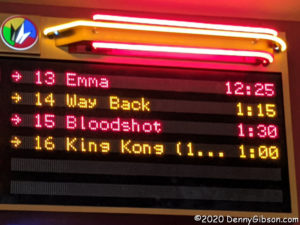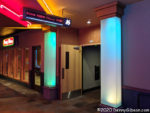 No, I’m not really going to review an eighty-seven-year-old movie that just about everybody has seen multiple times. But I am going to review the experience of seeing it on the big screen for the first time ever. The original King Kong was released on April 7, 1933, so it’s not quite eighty-seven years old but it’s mighty close. My first glimpse — and it wasn’t a whole lot more than that — was sometime in the mid-1950s.
No, I’m not really going to review an eighty-seven-year-old movie that just about everybody has seen multiple times. But I am going to review the experience of seeing it on the big screen for the first time ever. The original King Kong was released on April 7, 1933, so it’s not quite eighty-seven years old but it’s mighty close. My first glimpse — and it wasn’t a whole lot more than that — was sometime in the mid-1950s.
 It was on TV, of course, on what was decidedly NOT a big screen. It was probably in 1957 when the movie made its national television debut. The timing likely wasn’t considered “late-night” then and certainly wouldn’t be now, but it was late enough that I had to beg for an exemption to my normal bedtime. Although I was successful, I did not get the exemption’s full benefit. I fell asleep before the movie started, woke up to watch a few scenes through bleary eyes, then dozed off again before the big ending. Today I can’t even remember what portions of the movie I saw. I remember that I saw all of the giant gorilla, not just his face or hand, and I remember it was dark. Seeing Kong in his entirety narrows it down some. The fact that it was dark does not. The entire film was darkened to obscure, reportedly, some of the bloodier scenes and some details of Fay Wray’s femininity. Fay Wray had lots of femininity.
It was on TV, of course, on what was decidedly NOT a big screen. It was probably in 1957 when the movie made its national television debut. The timing likely wasn’t considered “late-night” then and certainly wouldn’t be now, but it was late enough that I had to beg for an exemption to my normal bedtime. Although I was successful, I did not get the exemption’s full benefit. I fell asleep before the movie started, woke up to watch a few scenes through bleary eyes, then dozed off again before the big ending. Today I can’t even remember what portions of the movie I saw. I remember that I saw all of the giant gorilla, not just his face or hand, and I remember it was dark. Seeing Kong in his entirety narrows it down some. The fact that it was dark does not. The entire film was darkened to obscure, reportedly, some of the bloodier scenes and some details of Fay Wray’s femininity. Fay Wray had lots of femininity.
Since then, there have been several viewings that I did manage to stay awake for. Although the screens were considerably larger and clearer than the one parked in our living room sixty-some years ago, all were on a TV. I think the movie became a favorite the instant I actually saw it all. The story was fairly creative but not particularly complex, and the acting was only a few steps removed from the silent film era. Neither was what attracted me to the film. I appreciated its craftsmanship and the window on history it provided. Stop-action animation and rear projection on matte paintings were not invented for King Kong but they had never been used anywhere near to this extent.
The window on history I mentioned exists largely because the movie was made as a window on, if not the future, the leading edge of the present. The film’s exciting finish features the Empire State Building which had just been completed in 1931. It was then the world’s tallest and would hold that title for almost forty years. The armed airplanes that attack the doomed giant were seen as “the most modern of weapons”. Some were models built for the film but some scenes show actual state-of-the-art military planes from a nearby U.S. Naval airfield. From two decades into the twenty-first century, those bi-planes look pretty primitive. Realizing that they represented the most advanced technology of the day definitely helps generate a real appreciation for the film’s special effects created with contemporary tools.
 On Sunday, I finally got to see the big guy on the big screen. Fathom Events put together a one day showing at Regal Cinema. Something I’d recently learned was that King Kong was the first movie with a thematic score. This means it was written to coordinate with and enhance on-screen actions rather than just provide some background music. Sunday’s showing included the opening and closing overture which had naturally been cut from every time-constrained TV version I’d ever seen.
On Sunday, I finally got to see the big guy on the big screen. Fathom Events put together a one day showing at Regal Cinema. Something I’d recently learned was that King Kong was the first movie with a thematic score. This means it was written to coordinate with and enhance on-screen actions rather than just provide some background music. Sunday’s showing included the opening and closing overture which had naturally been cut from every time-constrained TV version I’d ever seen.
The experience was nearly everything I’d hoped it would be. The wall-filling Kong was more frightening than any smaller version I’d seen, and Wray was every bit as alluring as I remembered, and her screams, with an assist from the theater’s sound system, were even louder. That thematic score, which I paid a little more attention to than usual, benefited from the sound system, too. If I ignored the fact that I was sitting in a wide well-padded recliner with NBA sized legroom, I could almost imagine I was watching like it was 1933.
The experience was only “nearly everything I’d hoped” for one reason. In the lead up to Sunday, I’d read a review of the movie which was really a preview of a 2011 screening. It’s here. My anticipation grew when it talked of “seeing it in a packed theater on a big screen with an audience”. I got the big screen but I did not get the packed theater. There were less than twenty people at the 1:00 show. I know that old B&W movies just generally do not draw big crowds but there was more going on here. COVID19, the disease caused by a Coronavirus, was growing. Large gatherings had been banned and the NBA, NCAA, MLB, and other groups had canceled events. In Ohio, schools had already been closed by the governor and within a couple of hours of me leaving the theater, he would close all bars and restaurants. Many museums and other institutions have closed on their own.
That’s why Sunday’s experience was about as far from a packed theater as is possible. Yesterday (Tuesday) the theater itself was closed and so was the Empire State Building observation deck. I’ve only been to the top of the Empire State Building once. It was in the early ’70s when King Kong was no more than forty years old. In a narrow space on an inside wall. there was a heart with the words “King Kong loves Fay Wray”. I’d like to think it’s still there but probably not.

Nothing like seeing the old classics on the big screen.
I saw “It’s A Wonderful Life” this past December on the big screen. It was a half full house and lots of laughing and sobbing at the appropriate parts. That ending always gets to me and really did on the big screen.
Definitely. I’ve seen a few including “Maltese Falcon” not too long ago and “Rear Window” before that. Rear Window was really great because it had been cleaned up with details visible that had been lost in the worn prints I’d seen on TV. A half full theater would have been great for “King Kong” because I got no sense of crowd reaction at all the way it was.
I love the original King Kong…
As a child, I was thrilled by it! I love all of the old thrillers, and monster movies…
I remember when I saw Freaks…That movie scared the crap out of me!
I would love to see King Kong with its original music score in a theatre setting.
Yep, the King Kong opening and closing overtures were an unexpected bonus. But the best thing about these old movies being shown again is that they are somehow cleaned up and restored so they aren’t as dim and faded as we’ve come to accept on TV showings.